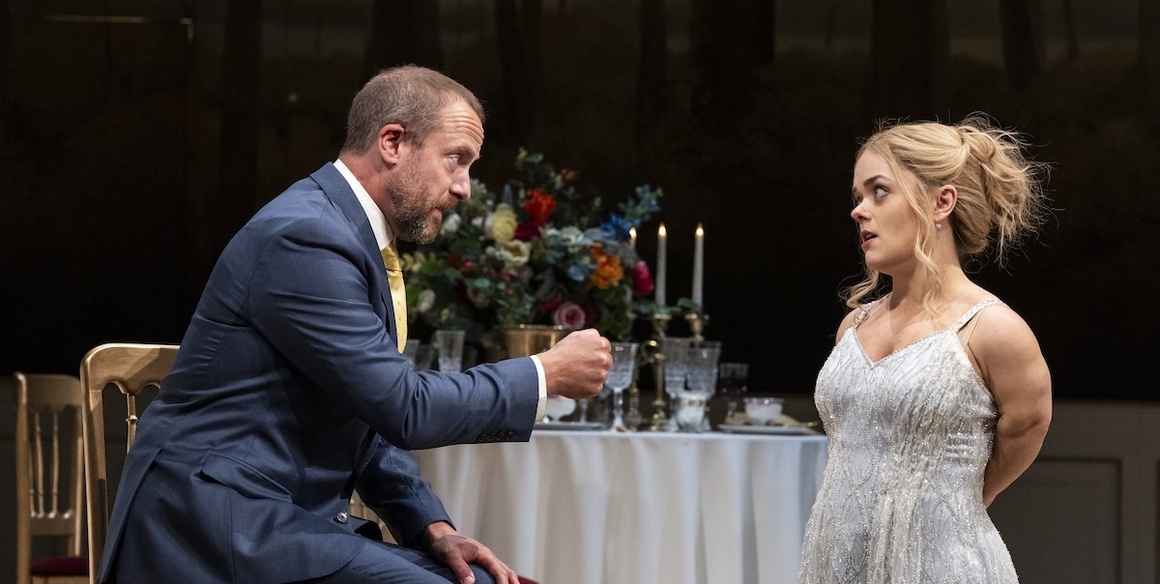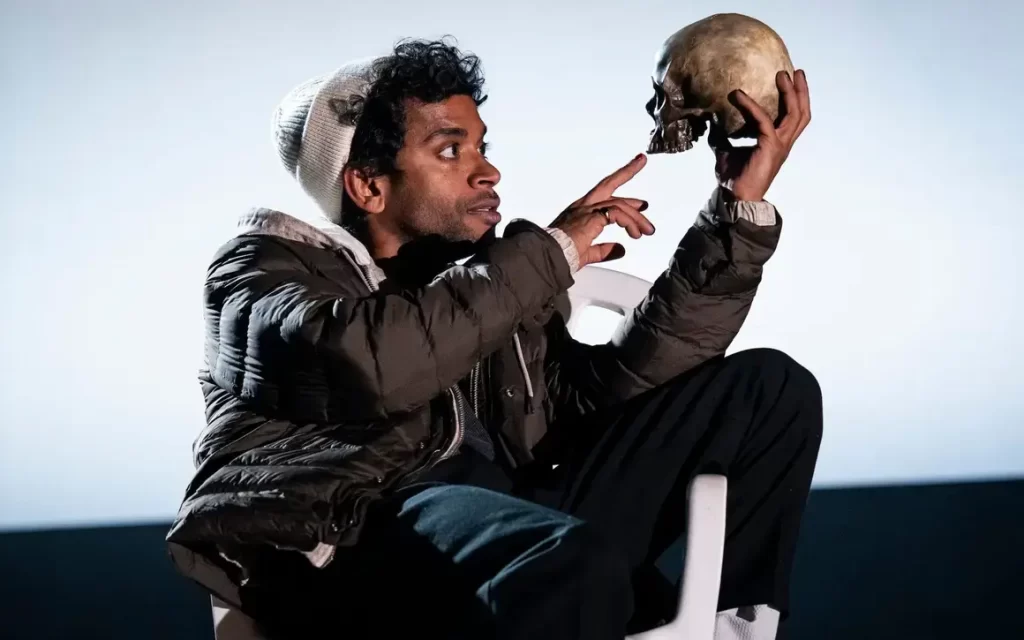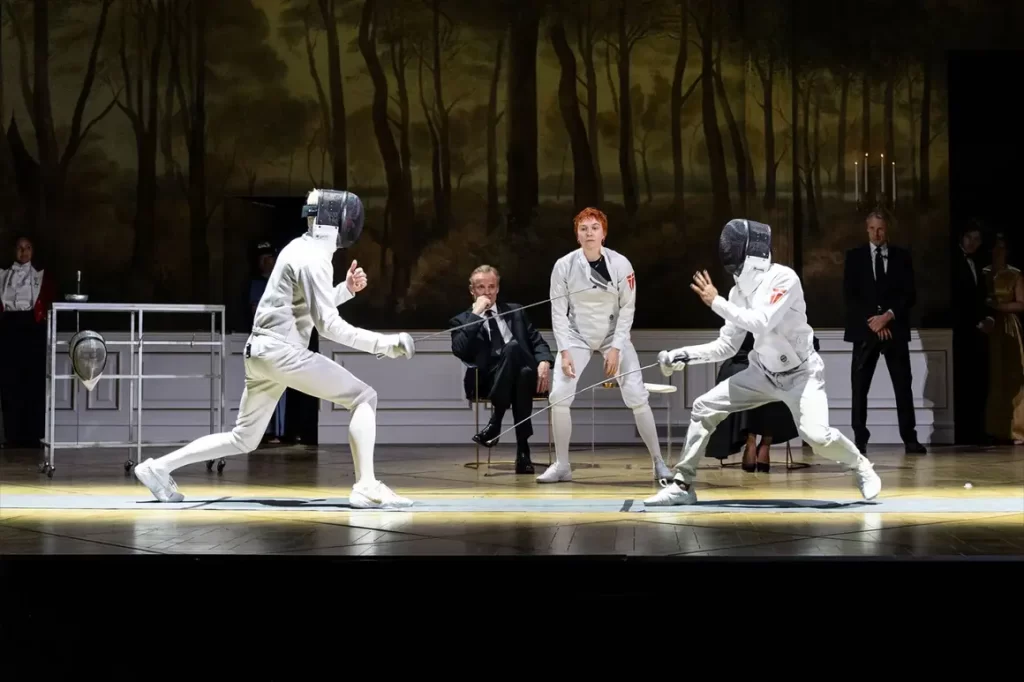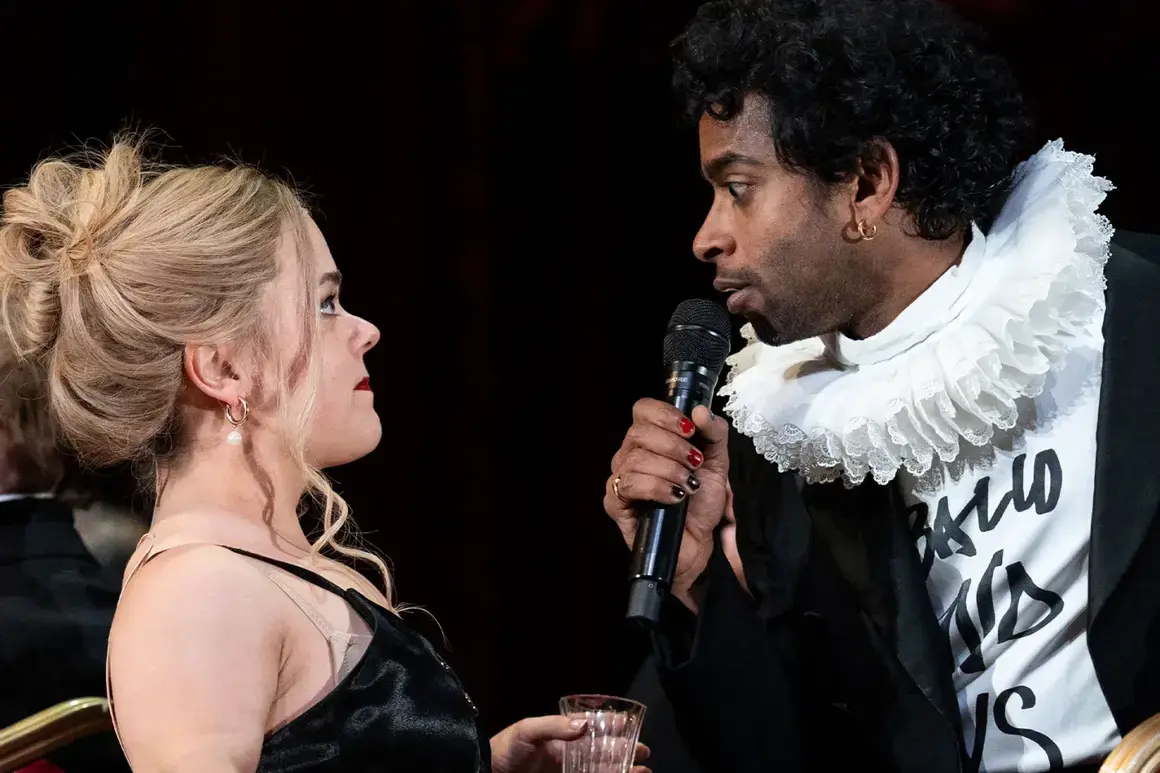Review by Simon Jenner, October 4 2025
★ ★ ★
Gertrude might not have had an affair with Yorick, but this Hamlet is his son. Whilst his father was off fighting, Hamlet must have learned much from Yorick, till he was seven: thus giving us the man, allegedly. It’s what he describes so vividly to Horatio, to whom he speaks truth. It’s certainly in the DNA of Hiran Abeysekera’s Hamlet, one more mercurial than lunar; with an antic disposition on steroids, handing out playbills for The Murder of Gonzago. Recalling his triumph in The Father and the Assassin, Abeysekera’s all clarity and velocity, except when he slows on “quintessence” and before the chop-fallen Yorick. Robert Hastie, known for Standing at the Sky’s Edge, and now the National Theatre’s Deputy Artistic Director, directs Hamlet at the Lyttelton till November 22.
This is a fleet Hamlet, playing just over two hours fifty. Neatly filleted it still manages to include the details of Horatio’s relationship with Gertrude, informing her of plots and conveying Hamlet’s letters. In this, and having both gravediggers, this production echoes the detailed, almost-complete Hamlet recently opened at Chichester. This is very different.

Geoffrey Streatfeild and Francesca Mills. Photo Credit: Sam Taylor
Words indeed buzz even beyond the hyper-antic Prince as both shared memory and uneasy permission. Three times during this production, when one recites, others chime in. First Geoffrey Streatfeild’s active Polonius with his precepts is beaten to it by Francesca Mill’s Ophelia and Tom Glenister’s Laertes, proving he must have recited it as a party-piece. But this communal memory is also a place of safety. It’s followed by a good-humoured family hug. Hamlet’s never been a Polonius till now, but this is exactly what befalls him when reciting his instructions to the players. Led by Siobhan Redmond’s First Player (a thrillingly contained, regal presence) they playfully chime in with him. Finally, when Ophelia recites her St Valentine’s Day song in wild distress, she’s both quoting it from the earlier wedding scene, and as Laertes tenderly bends over her, they come together on a last few lines. It’s immensely touching in a production where emotion is bleached along with an inordinate amount of blond hair.
Indeed Mills is the heart of this Hamlet; she’s from the start beyond courtly restraint. Not erotically, but emotionally. When instructed to return Hamlet’s letters, she and Abeysekera engage in a skirmish that bewilders her Ophelia, but it’s not malicious. Till Hamlet spots the book given to Ophelia and realises they’re being watched. His anger is shown as he tries to tear one of his returned letters and Mills snatches the box back. This Ophelia never wanted to return it. Mills, with sovereign phrasing as well as diction, enacts the distress in: “To have seen what I have seen, see what I see.” It curdles to an appalled recognition. She’s even assigned Liz Jadav’s Nurse. Later Ophelia’s distress is adorned as Mills enters with a fencing mask and sword (Claudius started this trend, we know how it ends) then a pair of proleptic angels’ wings. These are wholly unnecessary. Indeed I’m unsure about Mills’ posthumous muddy apparition to Gertrude. It’s striking, and a richer production might have made something of it, but it drips a little here. Mills with characteristic ferocity tears through this Ophelia and set. But she lends her grace to mourn, and space to convey that loss of self, of Hamlet the man overthrown, her family. She’s the truest thing in this production.
Tessa Wong’s Horatio also impresses as a true friend, a peacemaker and a little in love, at the least, with Hamlet; yet too loyal to intimate it. Wong’s great moment comes at the end: heartbroken yet resolute, she closes the wounds. It’s the most affecting close I can remember. You feel Kiren Kebaili-Dwer’s sterling Fortinbras is humbled into noble behaviour.
There’s less chemistry between Abeysekera and Ayesha Dharker’s warm, wary Gertrude. Or indeed between her and Alistair Petrie’s slightly chilly, utterly clear-sighted Claudius. Whereas Dharker shows a capacity to recoil from Petrie’s Claudius and seems most adept at grief – as if the death of her husband catches up with her – Petrie’s command is impressive. His dismissal of God in his failed prayers seems like a shutter severing his shred of humanity.
This Polonius echoes the production’s rapid-fire, and his foolishness is the result of a nervous fawning. It looses an over-hasty deluge of words. Once they leave him lost and asking for help, as if (as Coleridge observed) he can only summon the ghost of thinking. Streatfeild’s Polonius isn’t senile, but he is losing it. Yet he can order the surveillance and provoking of his son. Laertes in Glenister’s hands might wield a pistol but seems nearer his father than some, less choleric. There’s a startling grave scene where Mills is disinterred, but a streak of nobility too.
One promising trajectory shows how much Hamlet sees of his father. There’s no doubt at the beginning, with three others witnesses, and Ryan Ellsworth’s Ghost is solid enough. Later with Gertrude we see absence and silence through her eyes, not Hamlet’s; so his one-sided conversation seems indeed distract. Is his antic disposition sliding into something else? It’s not quite followed up. Nor are some roles. Whereas there’s deft characterising of the first on the opening scene, Francisco (Seb Slade), slightly more trigger-happy than Noel White’s more reflective Bernardo, and a spooked Marcellus (Phil Cheadle), that’s not true of Rosencrantz (Hari Mackinnan) and Guildenstern (Joe Bolland). Both fair-haired, they’re dismissed, unlike some productions, as a couple of Tweedles. Only Horatio winces for them, condemned by Hamlet. Elsewhere Mary Higgins’ Osric relishes flummery yet never guys it, and as Voltemand is anxious dispatch; along with Sophia Papadopoulos’ Cornelius, looking nervously behind her.

Hiran Abeysekera. Photo Credit: Sam Taylor
Ben Stones’ costumes are a timeless now, drawing little attention to themselves. More interesting is his set, lit sometimes spectrally by Jessica Hung Han Yun (often to the thrub of Richard Taylor’s score, at its best when spooky, recorded by the celebrated Carducci Quartet). The core’s a large, high reception room with striking pastoral tableaux: late Renaissance bastardized with baroque flying cherubs crossed with hunting scenes. It’s the digital artwork of Daniel Radley-Bennett. It does service for the first two acts and much of the finale. In between the set closes off into a diagonally arranged crimson-curtained affair. That does service for the Murder of Gonzago and rather messily, Gertrude’s bedroom; which boasts a convenient wheely trunk for Polonius to be trundled off on once he miraculously collapses on it. Though there’s more sounds off (Alexandra Faye Braithwaite) it’s the Carducci’s string sound that stays in the ear.
Kate Waters ensures the fight scene’s a suitable climax to Hastie’s fleet production. With its clever use of shared memory recitations as comfort blanket, it reminds us virtually no-one can speak truth publicly; save (as ever) Ophelia. Here she breaks through even her designated role, as Mills snatches vows back with the box of letters. This places further weight on monologues to deliver true feeling. Which often evaporates, with tricks at the edges like Hamlet’s use of a mic so his asides blast out publicly and pointlessly. “You would pluck out the heart of my mystery.” Yes, we would.
Nevertheless this Hamlet has the virtues of clear diction often delivered at a canter. Mostly lucid, emotionally it’s a Hamlet that but slightly knows itself. Abeysekera can dip into luminous wonder as in “Let be.” He’s enormous fun, a larky student prince not driven by inner furies but the power-plays of the quick and the dead. Tragedy he defies though, and seems to set his life at a straw with no great honour at the stake. The programme makes much of previous Hamlets, including the death-defying Ian Charleson, dying as he acted. Here there’s little of that risk, except for Ophelia. Much of the small beating heart of this production goes when Mills does; but for Wong’s Horatio who in those final moments reminds us why we should care.
Movement Director Ira Mandela Siobhan, Fight Director Kate Waters, Casting Directors Alastair Coomer CDG, Martin Poile CDG., Voice Coach Shereen Ibrahim, Associate Director George Staight,
Producer Fran Miller, Production Manager Mekel Edwards, CSM Lizzie Donaghy, DSM Emily Porter, ASMs Wen-Hsin Chiang, Devon James-Bowen (Book Cover). Digital Art Daniel Radley-Bennett.
The Company. Photo Credit: Sam Taylor



